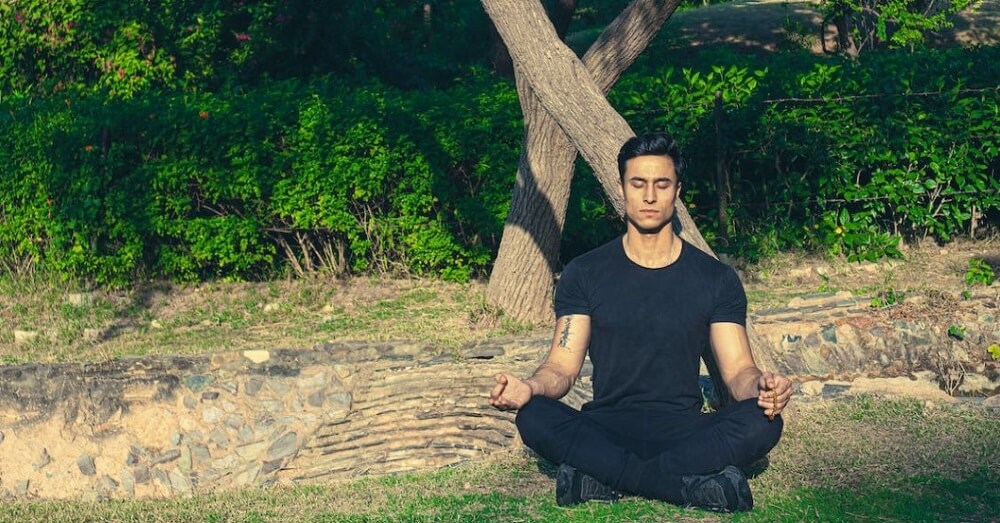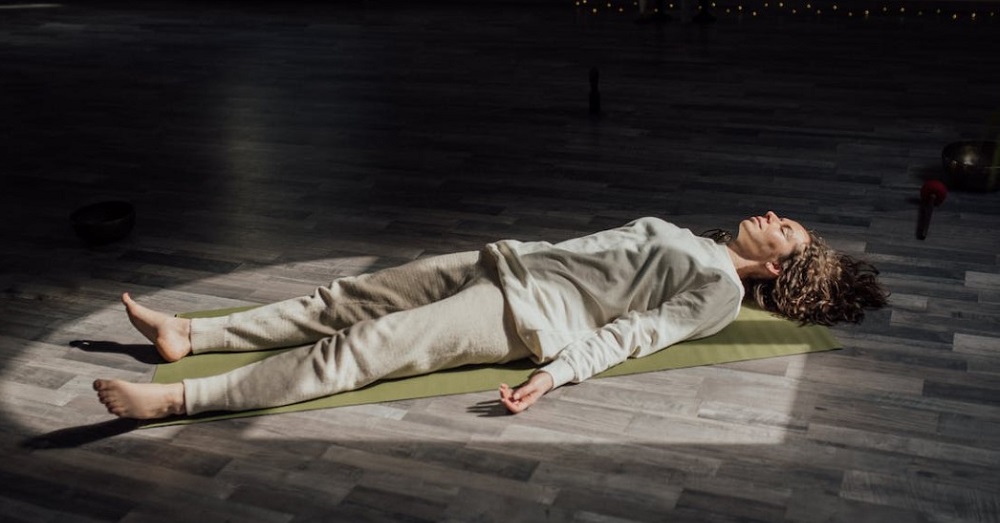Feeling anxious, exhausted, and overwhelmed is a common experience in our modern, fast-paced society. But it doesn’t have to be this way. No matter how chaotic the world may feel, we can cultivate tools and practices to help us feel centered, peaceful, and calm.
One of the best tools to combat stress and anxiety is meditation. And you don’t need to dedicate an entire hour or even 30 minutes to receive the benefits of meditation.
In this post, we’ll explore a simple 10-minute meditation practice that will help you clear your mind and discover the inner peace within.
Let’s get right into it.
Getting Ready for Your Practice

If you’re new to meditation, you might be wondering the best way to get started. Here are a few guidelines that can support your practice and set you up for success.
1. Find a Quiet Space for the Practice
While you can practice mindfulness in a noisy environment, it is usually best to find a quiet spot for guided meditation, especially if you’re just starting out.
Your environment doesn’t have to be perfectly silent; just do your best to eliminate distractions. Turn off your phone or put it on do not disturb mode.
Shut your door and let others know you want to have a few minutes to be alone, undisturbed. If necessary, use earphones to block out external noises.
2. Set a Timer
Set your alarm clock or the timer on your phone for 10 minutes. This way, you don’t have to worry about losing track of time during your meditation. You can also play a 10-minute meditation music track that will slowly fade out when the meditation is finished. This helps your mind stay focused on the meditation practice instead of trying to keep track of time.
3. Get Comfortable
Sit in a comfortable chair or you can lie down on your bed, if you prefer. However, if you’re feeling sleepy, it might be best to sit up to meditate so you don’t doze off.
Close your eyes when you are ready to begin. Besides preventing visual distractions, closing your eyes allows you to relax and release tension.
Take in a few deep breaths, making sure to breathe into your diaphragm to help you relax even more. To breathe into your diaphragm, expand your belly outward like a balloon as you inhale. Your shoulders and chest should remain relaxed. As you exhale, you can let your belly relax inward.
4. Focus On the Present Moment
By focusing your attention on your breath, you keep your mind in the present moment. It’s normal to get distracted and carried away by thoughts. As soon as you notice your mind trailing off, draw your attention back to your breath and the feelings in your body.
This practice will train your mind to stay present, which is the whole goal of meditation. Little by little, this practice of staying present will become easier.
In the beginning, don’t worry about your performance. Each time you get distracted, be kind to yourself and gently guide your mind back into the moment. It doesn’t matter how many times you get distracted.
What matters is that you are showing up for the practice and intending to stay present. Over time, this practice will allow you to let go of the chaos of the world and cultivate a sense of inner stillness and peace.
5. Ease Into Other Activities
When you finish your meditation practice, take your time transitioning into the rest of your day. You can slowly open your eyes, stretch your limbs, and gently ease into other activities.
This way, you carry a sense of calm and peace with you into the remainder of your day.
A 10-Minute Guided Meditation for Relaxation

Now that your environment is set up and you know the basic guidelines, you’re ready to begin meditating. Here are the steps to practice a simple, relaxing 10-minute meditation.
- Close your eyes and observe your breath for a few moments, allowing yourself to breathe at your natural pace.
- Breathe in deeply through your nose and gently breathe out through your mouth. Repeat this a few times, slowly and deeply.
- Bring your attention to your body, noticing the sensations that you feel. Starting with your toes and moving up toward your head, slowly scan your body with your awareness, observing what you feel. If you notice any areas of tension or discomfort, acknowledge them and consciously relax those parts.
- When you have finished scanning your body, bring your attention back to your breath. Inhale slowly and deeply through your nose, and gently let the air out through your mouth. Notice the sensations of the breath as it flows in and out of your body.
- As you breathe in, imagine that you are drawing peace, ease, and relaxation into your body. And as you breathe out, imagine that you are releasing any stress, tension, or negativity you may be holding onto.
- Don’t worry if your mind starts to wander. Simply acknowledge any thoughts that come up, and then gently return your focus to your breath.
- Take a moment to visualize yourself meditating somewhere in nature. It could be near a river, waterfall, beautiful beach, tranquil garden, or any peaceful place that creates a sense of relaxation.
- Allow yourself to experience the peace and serenity of this place. Notice the sights, sounds, and smells that you imagine. Stay in this calm and peaceful place for a while.
- When you are ready to end your meditation, take a few deep breaths in through your nose and gently exhale through your mouth. Bring your attention back to your body. Wiggle your toes and fingers, and stretch your arms and legs.
- When you’re ready, slowly open your eyes and take a moment to reorient yourself to your surroundings.
- Observe how you feel. Notice if you feel more calm, centered, and relaxed than before the session. If you don’t notice any difference in the way you feel, that’s okay too. Just witness yourself in this moment, and congratulate yourself for showing up to meditate today.
You can practice this 10-minute guided meditation whenever you need to take a break and reset.
If you would like to try meditating with soothing background music, check out this Nature Sound Retreat album for 30 different 10-minute tracks with calming music and nature sounds to help you relax while you meditate.
Common Meditation Mistakes to Avoid

Research shows that meditation, even for short periods, can be very effective over time. To make sure that you enjoy the practice and receive the health benefits of meditation, here are some common pitfalls to avoid.
Trying Too Hard
It may sound counterintuitive, but trying to meditate can activate your thinking mind even more. Instead of trying to force your mind to be silent, just focus on relaxing instead.
Give your mind a job to do – watching your breath. The more the mind can center on a simple task, the more it will naturally become calm and quiet.
If you find yourself getting frustrated with meditation, refocus on relaxing as much as possible. No matter how scattered your mind may be, it’s okay. The more you relax, the more your mind will calm down, as well.
Simply observe your breath, relax your body, and allow yourself to enjoy being present in the moment.
Getting Caught Up in Distractions
Distractions during meditation can be external in your environment or internal within your mind and body. While you might find these distractions annoying or frustrating, the more you focus on them, the more you strengthen your awareness of them.
It’s better to acknowledge a distraction and then let it go with ease, coming back to the awareness of your breath. Imagine that distractions are like clouds passing by in the sky.
You don’t need to hold onto them, analyze them, or change them. Just let them come and go like clouds, always returning to the present moment by noticing your body and your breath.
Judging Yourself and the Experience
Every day and every meditation practice is different. Some days it will be easy to relax and find inner peace. Other days you may feel overwhelmed by thoughts and feelings.
That’s totally normal, and it’s all a part of the practice. Remember, you don’t have to be perfect at meditation. It’s not possible anyway. Just do your best and be gentle with yourself. The fact that you showed up to meditate is already a big success.
Expecting Immediate Results
Have you ever heard the phrase: the journey is the destination? That’s very much how meditation works. If you are looking to arrive at a place in your meditation practice where it’s always easy or you get immediate results, you might be disappointed.
If you keep an open mind instead, you’ll notice that each meditation practice strengthens your focus, builds upon your sense of inner peace, and provides you with insights about yourself.
These benefits aren’t usually gained with instant gratification. With meditation, the journey is the destination, and enjoying the practice makes it all worth it. Over time, the subtle changes from your meditation practice will shift the way you see life and yourself.
Not Making Time for the Practice
Consistency is key if you want to receive the benefits of meditation. In fact, practicing shorter sessions every day is more effective than practicing a longer session once a week.
Even if you only have 5 minutes to spare, you can receive great benefits from developing a meditation routine. Practicing short meditation sessions every day will help you form a healthy habit and mindfulness will become second nature.
Best Times to Meditate
What’s the best time to practice meditation? It’s different for everyone and depends on your schedule, energy levels, and preferences. You can practice any time of day that works for you, even multiple times a day if you’re practicing short sessions.
With that said, here are some suggested times you might want to consider:
- Before you get out of bed: Rushing out of bed can make the day’s responsibilities feel overwhelming. On the other hand, starting the day with a morning meditation sets a positive tone for the rest of your day.
- Before starting a task: Take time to center yourself for a few minutes before showing up at work, doing home chores, or attending classes.
- During break time: You can do a 10-minute guided meditation any time during your day when you need to take a break and reset your mind.
- Before dinner: Meditating right after work hours or just before dinner helps you relax and de-stress after the day’s activities.
- Before bedtime: Ending the day with a 10-minute sleep meditation will help you clear your mind and let go of stress. This will help you fall asleep with ease and will improve your sleep quality.
Now that you have all the tips and tools to practice meditation, give this relaxing 10-minute meditation a shot. It’s never too late to get started with meditation, and you’ll be so glad that you incorporated this calming practice into your daily life to cultivate inner peace and tranquility.


